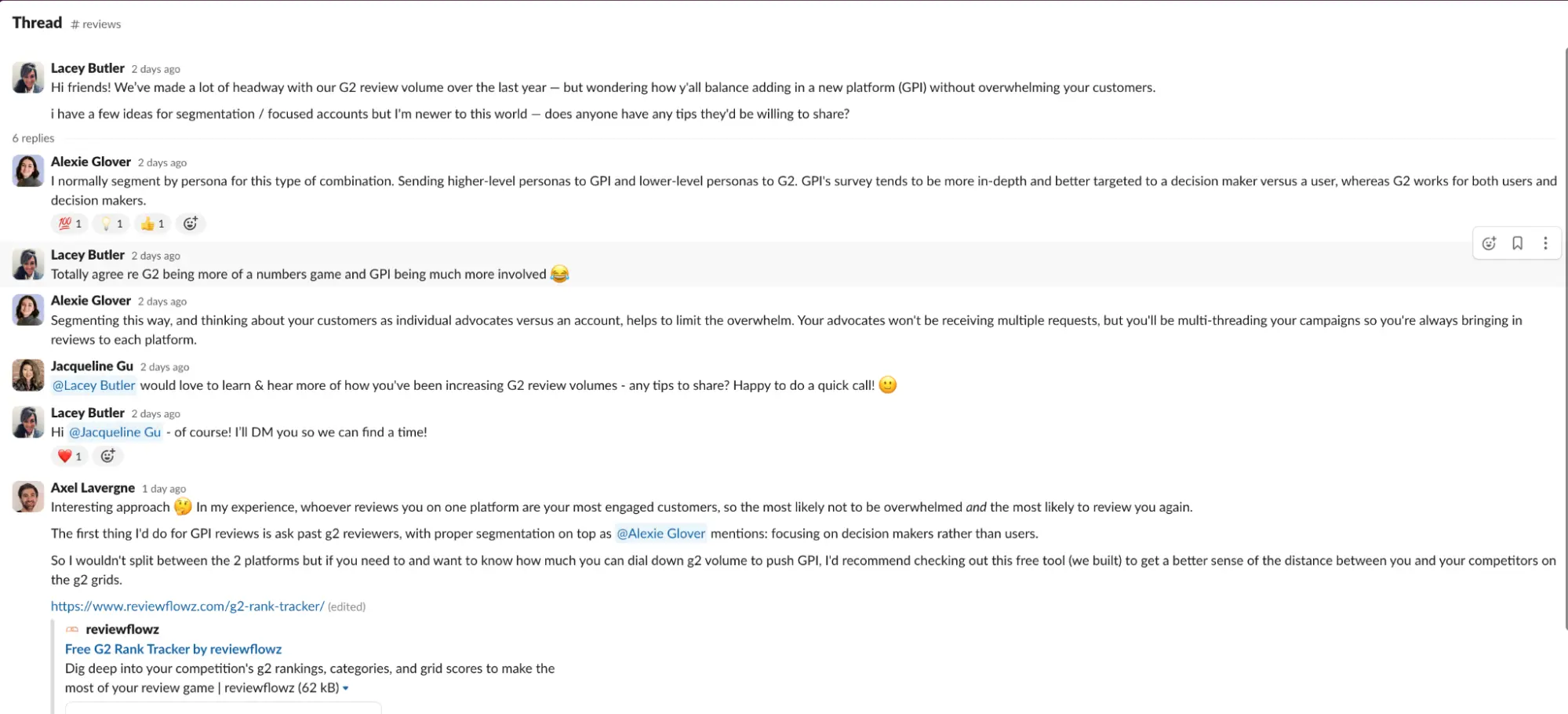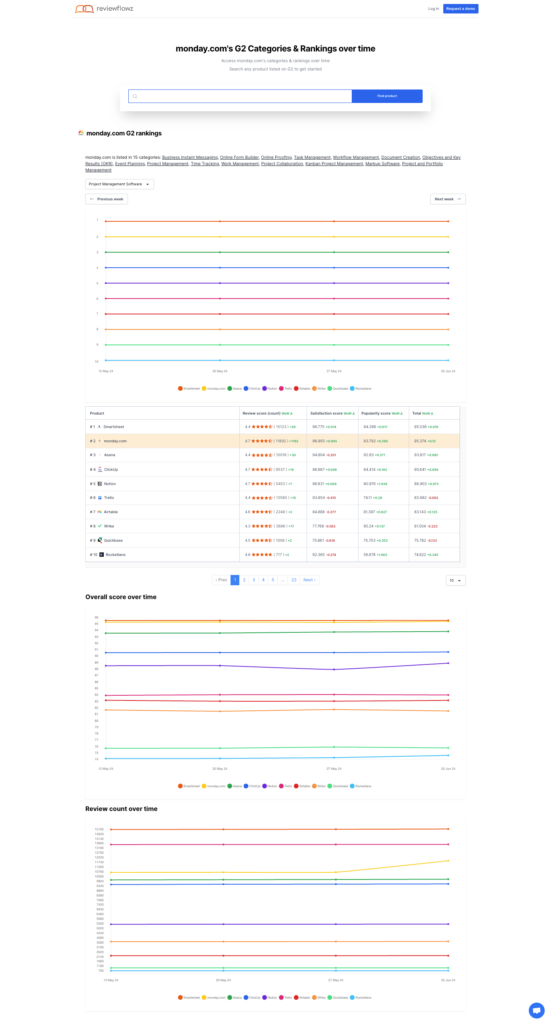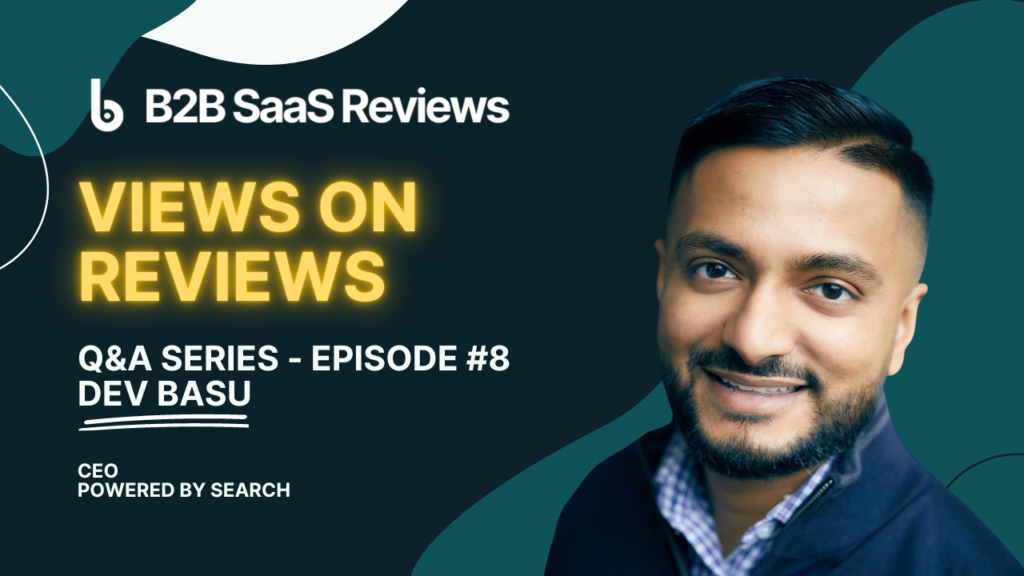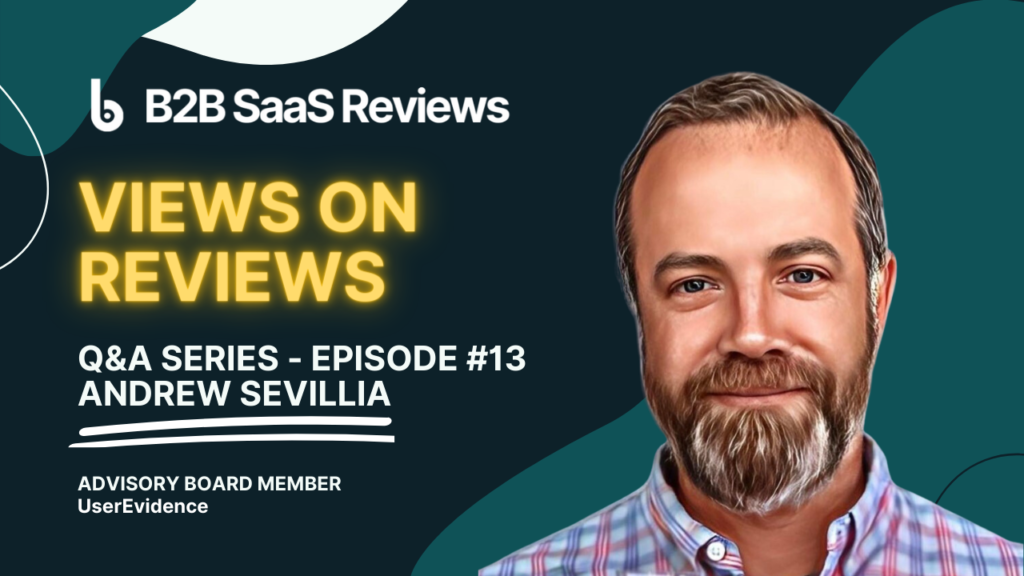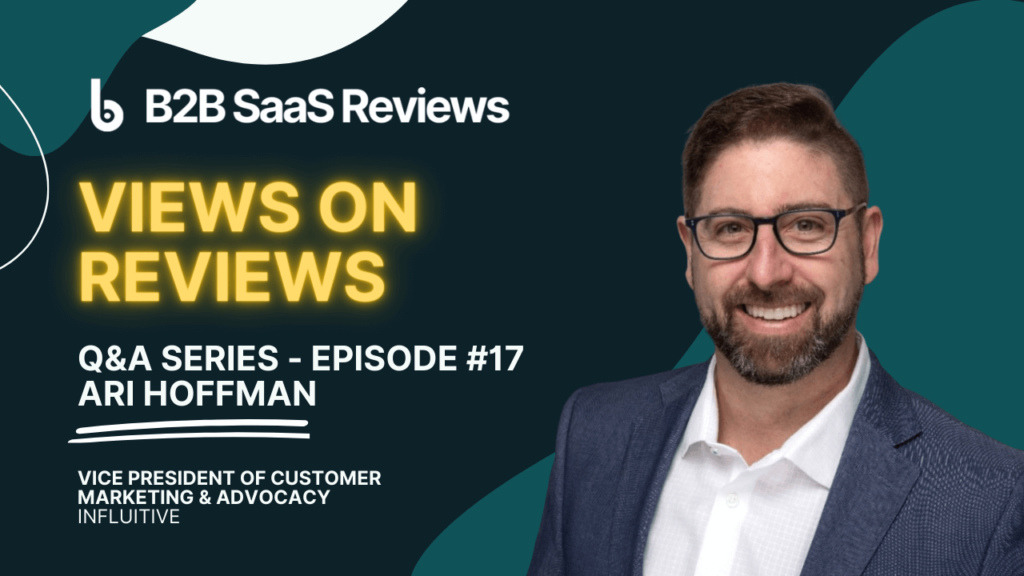Axel Lavergne is the Founder of reviewflowz, a review management tool for software companies. To the best of my knowledge, it’s the only software solution on the market for online review management in B2B software.
He’s also been in the shoes of a B2B marketer tasked with generating reviews, as he was the Head of Growth at Sendinblue (now Brevo), which has thousands of reviews across multiple software review sites.
Axel meets with many marketers to discuss and work through their review generation strategy and tactics.
I think there’s a lot to learn from Axel when it comes to reviews, as he’s “walked the walk” as a vendor asking for reviews and now works with dozens of companies on reviews through his work on Reviewflowz.
So, I’m excited to get his expert views on reviews and share them with you.
Here they are:
My Interview with Reviewflowz founder, Axel Lavergne
You and I have got to know each other over the past few years as we’ve discussed the software reviews space and what reviewflowz is aiming to do for it. Can you start by telling us how reviewflowz came to be, and what problem you saw that it could solve for?
Axel: Sure! It all started back at Sendinblue (now called Brevo). The founder Armand had setup a channel called #reviews and wanted to get reviews from every platform sent there.
The reason for that channel was essentially bringing the customers’ voice inside the workspace. Dharmesh Shah (CTO at Hubspot) talks about it in this video.
After seeing quite a few organizations (both small and big) set this up, I can vouch for the impact it has on a few things:
- You can never get caught with your pants down. I didn’t really understand this back then – first job and all – but as a founder, there is something visceral about how your brand and product are perceived. Knowing you won’t miss something brings a peace of mind you wouldn’t believe to you, and to top management.
- Reviews become important organizationally. For everyone. They’re a part of everyday conversations, just like they’re one of the 30-something Slack channels.
- It brings Product, Marketing, and CSM together around real-world problems. More often than not, a customer review (and the 40-ish message thread that followed) was the reason why something important changed at Brevo. My customers share this impression.
- Accountability: nobody likes blaming a CS agent for a bad review. Of course it’s never that simple. But knowing that if you shit the bed, it’ll go on Slack for everyone to see definitely helps keep everyone focused on finding a solution.
As the Founder of reviewflowz, you’ve had the chance to speak to many marketers about their approach to reviews. With all the knowledge and expertise you’ve accumulated, what’s your advice on how B2B software should design a review strategy?
Axel: So I think it depends on what stage your company is at.
If you’re just starting out, your main focus is on making the shortlist. So discoverability is going to be key right?
Very much like in SEO, discoverability boils down to making the top 10 on the right pages. So pick the categories with the right blend of quality and quantity of traffic, and work your way up the ranking.
If you’re more of an established brand, your focus would probably be on owning the narrative.
- Do you want to be the leader in one category because that’s the direction top management wants to take?
- Is being a challenger in that category fine because you have a slightly different pitch?
- Is there a specific integration (i.e. market) you want to break ground in?
- Or do you need an impeccable record when people google “{{your brand}} reviews” ?
Usually, the bigger the organization, the more of these objectives are going to be relevant, and it becomes a case of how do you build systems so you can confidently ensure you hit the mark on all objectives, and focus on the one that’s the most critical.
Follow-up question: once you have a review strategy, how do you advise companies to think about where to get them (i.e. on which sites to collect reviews)?
Axel: So in my opinion it all boils down to the incremental value of a marginal review.
Fancy words, I know, but hear me out.
Marginal review just means one extra review.
Incremental value means compared to the current state.
First, are you active on Google Ads, and how active are you?
If you’re not sure, find out. There are “star rating” callouts on Google Ads, and while nobody can really say for sure, the general consensus is that they help increase CTRs by 5 to 10%. Ask anyone working in PPC how much a 5% CTR increase is worth to them, and they’ll tell you a lot.
So if Google Ads is important to your business, you’re going to need a google certified review platform. There’s a list of a little under 30 review platforms that google will accept for their Google Ads callouts. The most famous ones include Trustpilot, Reviews.io, and Yotpo. In B2B, mostly everyone goes to Trustpilot for the light feature set and price point.
Luckily, getting a google certified review is not nearly as difficult as getting a g2 or GPI review. It’s usually just a star rating, title, and general comment field. So you can probably ask almost everyone for a review there.
Second, discoverability.
What are the main categories your software is listed under, and how important are those category pages to your business?
Odds are, you’ll identify a few G2, Capterra, GetApp, SoftwareAdvice, Trustradius, or Gartner Peer Insights pages.
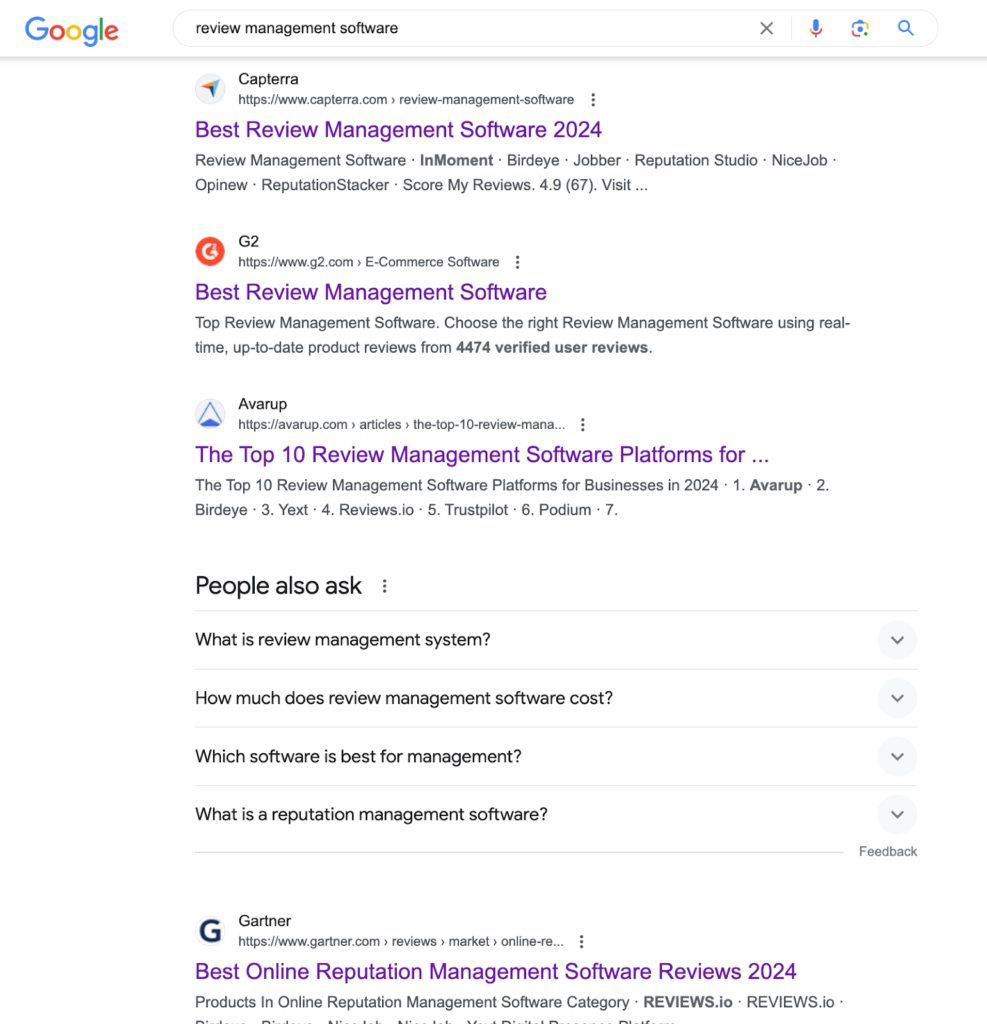
Maybe also some niche platforms depending on your business.
Do not underestimate software integration marketplaces here. For example, if you’re looking for a wordpress form builder, would you go to the wordpress plugins marketplace, or google it?
The good thing is that Capterra, Getapp, SoftwareAdvice all use the exact same review set. So if you get a review on one of those, you’re getting a review on all 3. On some google SERPs, this matters a lot. It’s not uncommon to see all 3 platforms ranking top 10 on a specific keyword, and it sends a very strong signal if you’re top of the pile.
The downside is that there’s probably a bunch of paying players on top of the category, so reviews won’t really help you outrank them.
With this in mind, try to hone in on the value of a single review on each of those platforms. For each platform, write down the number of reviews you’d need to make the top 10, top 5, and top 3.

Also try to get a sense of the review velocity – number of new reviews per month or quarter – for each player in these categories. You’ll need to add this to figure out how many reviews you’d need to outrank them.
Now, you should have an estimate of the # of reviews you need to get to a certain position within a certain timeframe.
Given your own estimated velocity, you should be able to get to a “Time to strike” value for each position on each platform.
Now it’s just basically just a matter of figuring out what gives you the most visibility.
Keeping in mind that category pages work pretty much like google search engine results pages – exponentially. The first result gets 40% of the clicks, and the 10th one gets 1.5%. That’s 25x more clicks for the first one (source). I’d expect a similar distribution (although less extreme) on review platforms category pages.
Third, reassurance, or social proof.
Once you’re discoverable and discovered, people will google “{{Your Brand}} reviews” and very probably read your bad reviews.
This is where review management comes into play.
Make sure the message you’re sending across all platforms is consistent, and relevant. Avoid templated answers that simply acknowledge reviews, or worse, blame the customer.
One thing to keep in mind is that bad reviews bring bad reviews. Do not let bad reviews accumulate before it’s too late to do something about it. Mailchimp’s trustpilot profile is a great example of what not to do.
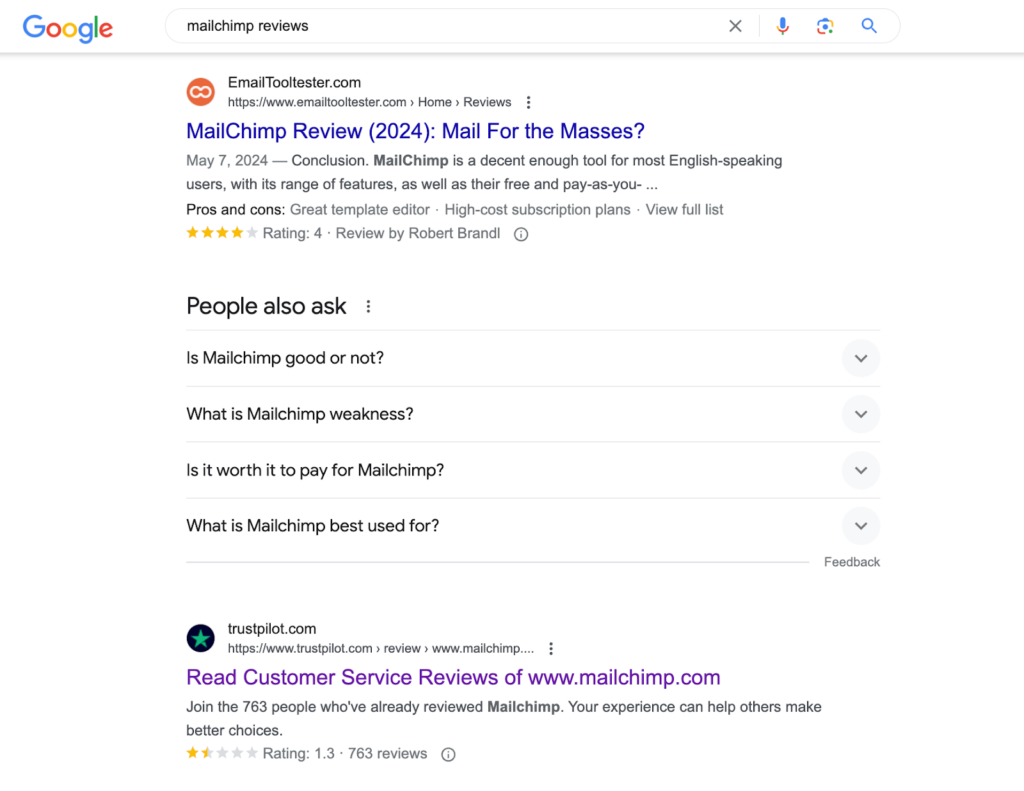
Another follow-up question: once you have a review strategy, and are ready to collect reviews, how do you go about getting them? What are the typical “triggers” you recommend for automating review requests?
Axel: So in an ideal world, you want the triggers to both signal real customers, and be high volume.
NPS is very widely used, mostly because it’s always common to leverage it as a marketing segmentation tool, so marketers are used to the idea. The main issue with NPS though, is volume. You need to survey a lot of customers to get a significant sample. So if you’re in the high ACV, low user-count sort of business, odds are NPS won’t get you very far.
Some people seem to believe in-product surveys are the answer to everything. They’re not. They’ll get you some volume, but nothing over 2x what email would get you. And you’ll be degrading the product experience for every user. They can definitely be an effective tool to target specific segments though.
One thing to add here: although you want decision makers to review your software, don’t limit yourself to them. You can segment and adapt the message, but if you have tons of users who aren’t decision makers (for ex: in the CRM space), leaving users out of your review campaigns is just lazy. There’s no valid reason to do that.
The very best trigger in my mind is a positive, public review. If a customer is engaged enough to review you on a public platform, they are – by very far – the most likely to review you (again). Success rates on those campaigns are usually in the 80% range. So long as you can double down on whatever promise you offered first.
The next best trigger is a positive conversation. This is where it gets very tricky. If you’re in a prosumer sort of business, you can leverage customer support interactions – we wrote a little post explaining how to automatically follow-up on a positive CSAT rating on Zendesk for example. This works wonders for high-volume prosumer-type SaaS companies.
If you’re in a higher ACVs, lower support interaction volume business, CSMs should really be your go-to. I profoundly believe that marketers should not want to own the conversation if someone already does. So it becomes a case of figuring out the right incentive to motivate CSM teams to gather reviews.
Whatever you do, do not, under any circumstances, blast your customer base with g2 or capterra emails they never asked for.
- First, you’re effectively giving your customer list to those platforms. And they’re openly selling “intent data” – a.k.a customer lists – to your competitors.
- Second, their collection rates are terrible. If you’re going to spam your entire customer base with 3 emails, aim for 30% collection rates at least. They’ll get you 10% tops.
- Third, they all have review decay factored in now. 30 days after your campaign, your reviews will weigh 90% of what they weighed on day one. If you’re not doing always-on campaigns, you can’t win.
- And finally, if you think a random copywriter can do a better job at getting your customers to talk about your product, you are not thinking straight. There aren’t a million ways to ask for a review, so even your worst attempt would beat the generic emails they’d send for you.
And if you’re concerned about the incentives and the budget and all of that, go back to the basics, evaluate the value of an extra review, and build a business case from there. There is no valid business reason to save $2000 and miss out on 20 extra reviews from the same customer base sample.
You and I recently talked about how growth marketers like you and I see reviews a bit differently compared to how customer marketers & advocacy professionals see it. I think this recent conversation in the CMA community illustrates this. Care to speak to it here? What are the potential strengths and weaknesses of each function’s view and approach, and what can we learn from one another?
Axel: Ahah this was a great thread yes.
So I think in this conversation, Lacey is trying to do the best job she can in her segmentation to get the best conversion rate possible.
She also mentions “Without overwhelming your customers”.
I think marketing pressure in general is a very important aspect of every customer marketer’s job. You want to reach out to customers and you’re constantly asking them for different things: reviews, testimonials, case studies, references, etc.
Often, you’ll end up asking the CSMs who own the relationship to help you out, and they’ll be tired of asking things because their objective is to ask for more money. And if you’re asking more and more one-to-one you’d probably feel the exact same way right?
There’s tension there, inherently, and it’s not going away.
But if you take a pure marketing standpoint, you’d want to only talk to the most engaged customers right? For example if you run a newsletter, you’d clean up the list every quarter or so to remove non-openers, and keep only the most engaged readers, right?
Somehow, most customer marketers end up looking at this the other way. Like, trying to limit the number of contacts with the most engaged customers (in this case G2 reviewers) rather than talking only to them.
And if you’re to bring value to someone, these are the someone’s you should focus on! Give them guest posts, customer spotlights, share their stuff on Linkedin, etc.
I think it really comes down to the one-to-one VS one-to-many conundrum we’re all facing. As growth marketers, we look at segments, and we tend to focus on the segments that have shown the most engagement, just because the numbers are higher, and they grow faster.
In a one-to-one relationship, we tend to want people to like us a lot more than we actually need them to. You’re bringing value, inherently, with the product. So much so that people are willing to spend time with you, and tell the world.
The truth is obviously somewhere in the middle here. You don’t want your happiest customers to run away because you bullied them into spending too much time with you, but to be honest, I don’t think I’d be able to bully anyone into doing a case study.
My note:
When Axel and I were chatting, we found that, in our experience, customer and growth marketers tend to approach reviews from a vendor point of view a bit differently.
Axel noted that growth marketers see the world in 1-to-many segments, and Customer marketers tend to see more in 1-to-1 relationships.
Another way to see this is that customer marketers focus more on nurturing customer relationships than growth marketers.
On a spectrum with building relationships at one end and maximizing transactions at the other, customer and growth marketers are typically near the other ends.
One way this manifests is who we ask for reviews: Customer Marketers tend to limit their review requests to one per customer to avoid overwhelming them, whereas growth marketers tend to ask customers who’ve written a review on one site to write reviews on other review sites to maximize review generation.
Another way to look at the differences is qualitative vs. quantitative.
Customer marketers are more likely to value the qualitative side of reviews, like creating authentic, voice of the customer content that can be mined from it.
In contrast, growth marketers are more likely to value the quantitative side of it, like how many reviews are needed to rise the ranks in a review site category to capture more in-market demand by being considered and evaluated by more buyers.
In my opinion, there are pros and cons to each approach.
If we learn from one another, we can find a middle ground with the best of both worlds.
You’ve covered the difference between review management and review monitoring and shared 5 top use cases for review monitoring (see the article linked in the response). What’s your “elevator pitch” for someone new to the “review monitoring”? What do you find gets people to go from seeing it as a nice-to-have to need-to-have?
Axel: Setting it up!
Ahah. Jokes aside, I think review monitoring is actually the first step to start looking at review management.
You can’t optimize it if you’re not measuring it right?
I think the first eureka moment typically comes when reviews start flooding in the Slack channel.
A week or two after that, I almost always hear from the customer that they want to send reviews to their helpdesk, or that they need more reviews on this or that platform, to add reviews to their BI tool, or show them on their landing pages, etc.
So really monitoring is the first step in doing anything with reviews in my mind.
Reviewflowz is actually becoming a full review management suite for an increasing number of our B2B SaaS companies. We’re shipping an increasing amount of features to understand where a review is most valuable, and then to actually get more reviews there.
Note: here’s the article I referred to in the question: Review monitoring: What it is, What it isn’t, and Why you need it
You’ve built reviewflowz as an easy-to-use online review monitoring tool that can serve companies in a variety of sectors. In your experience, what are the main differences in the way that the people you speak to at B2B software companies vs. other sectors, like multi-location B2C companies, view reviews? Are there things that one can learn from the other?
Axel: So the first thing that comes to mind is bad reviews.
Consumers, and prosumers to an extent, are typically treated a lot worse than B2B customers. ACV is an obvious scapegoat, but there’s also a sense of “it’s not my money” on the buyer’s side which makes the conversations a lot easier in the b2b space.
So consumer-focused businesses are very much focused on mitigating bad reviews, while a bad review in the b2b space tends to raise a lot more questions.
Another very different aspect is volume. Consumer focused businesses typically have a lot more customers than B2B focused businesses. Not to mention that it’s a lot easier to drop a review on Google Maps or Trustpilot than it is on G2 or GPI. That, in and of itself, also explains the bad review mitigation aspect.
So I would think the main difference is that reviews are pretty much a nuisance at this point in the B2C space, when they’re still – to an extent – considered an opportunity for a lot of B2B companies.
What this means for reviewflowz is our consumer-focused customers tend to use it more as a way to react to positive and negative reviews, while b2b-focused customers use it more as a measuring and reporting tool, to get a better understanding of how well they’re doing, where to focus their attention, and how to maximize the impact of their review collection.
That being said, the consumer side of this has been doing reviews for a lot longer, and they typically have acquired a lot more maturity.
They’d have review collection systems of all sorts, processes to handle bad reviews, etc. – where most of the b2b companies don’t have always-on campaigns, feedback collection processes, or escalation strategies to handle bad reviews when all else fails.
You recently made a free G2 rank tracker? Can you tell us about who you designed it for you, and what it can help them do better?
Axel: This G2 rank tracker is sort of the first step to help our customers get to the value of an incremental review more easily.
Basically, we take a picture of the G2 categories you’re listed on every week, and with it the satisfaction and popularity scores of your brand, and your competitors.
What this gives you is the relative distance between you and your competitors in each category. And how it evolves over time, and as new reviews come in.
So if 40 reviews get you a 0.5 satisfaction score increase, you can actually evaluate how many reviews you need a lot more accurately to outrank your competitors.
This allows our customers to have data-backed conversations when asking for budget and defining objectives.
It also tells you what categories your competitors are in, which often helps identify growth opportunities.
And it helps track progress in between position changes, as it can often take weeks, or months, to outrank a competitor on G2. This will tell you if you’re on track, and give you a sense of when you should reach your objectives.
Joe’s note: here’s an example showing the (insane) number of reviews (1162) collected by Monday in one week, and the impact it had on their satisfaction, market presence, and overall scores.
To determine how many reviews Monday needs to overtake Smartsheet for 1st place, they could subtract their total score from Smartsheet’s total score (95.536 – 95.374 = 0.162) and compare that number (0.162) to their “WoW” (week over week) score (0.15), and conclude that they need another big review push of about 1400 reviews (assuming the new review scores are similar to the previous week.
In my talks with B2B marketers, there’s a lot of negativity about the current state of reviews. What’s your take on where we’re at and where you think we’re headed?
Axel: I mean at this point, most software review platforms have become testimonial platforms.
I’m not sure why everyone hates that so much.
Searchable, relatable, detailed testimonials are a godsend for anyone evaluating software.
I think a lot of the negativity stems from the idea that they should be objective reviews and all that.
Realistically though, B2C customer relationships and B2B customer relationships are vastly different.
There are a million reasons why things could go really bad in a b2b relationship, and only very few of them would justify spending 10 minutes filling out a form on G2 or Gartner.
So sure, there is inherent bias in who’s going to take time to fill in a review. Not sure how that works with cherry-picking compliance and all that but let’s assume it works.
Are reviews the best way to accurately rank software within a category? Probably not. But what’s the alternative?
- The amount of money you can spend on getting backlinks?
- The amount of money you can spend on content and marketing ops excellence?
- The amount of money you’re willing to spend on influencers and affiliates?
- The amount of money you can spend on Google, Meta, and Linkedin Ads?
I think a lot of the pushback around review platforms really comes down to the age-old “Marketers are bad”
And whether you can incentivize customers, incentivize CSMs, at least those review platforms have made sure you can’t just buy hundreds of reviews on Fiverr – you’ll need happy customers, and you’ll need them to be willing to review you.
As to where this is going, my very bullish point of view is that ranking algorithms everywhere are going to increasingly leverage social proof and the voice of the customer.
When Google came up with the “backlinks mean you’re credible” pitch, it pretty much defined the internet for the next generation.
As acquisition costs keep increasing, and as authentic content becomes more and more rare, I believe buyers will increasingly use review platforms to build a shortlist, and to evaluate software.
Simultaneously, as software consolidates under massive conglomerate-ecosystems (Salesforce, Hubspot, Shopify, etc.) – AI is strongly pushing towards that in the sense that the more data, the better the AI – I believe integration marketplaces are going to be critical to customer acquisition.
What these two have in common is the ranking currency: customer reviews.
Which really boils down to my vision for reviewflowz. While there’s a sense of panic with search slowly shifting towards social media & influencers, the one thing that’s not going anywhere and that will consistently keep growing is review platforms and integrations.
For anyone working on reviews for a B2B software vendor, what would would be the top 3 things you’d like them to know about reviewflowz?
Axel:
- If you need more reviews, we can help! We shipped a pretty extensive review generation feature set and we’ve been getting really cool feedback from inventive and highly successful customers in the space.
- Information is power. It’s been amazing to think we played a small part in seeing some of our customers win budgets, blow their objectives out of the water, and free up time to focus on longer-term high value-added projects like case studies, references, customer communities, etc.
- If you’re not ready to buy, I’m confident you will eventually be, so I’m always happy to take a call, and I don’t push for sales. A few of my demo-calls end up being a chat about review strategy and how best to address current challenges. If anything, I think it’s helpful to bounce ideas off someone every once in a while.
My Key Takeaways
I think there are many great takeaways from this interview for vendors working on review management.
Here are the ones that really bubble to the top for me:
- Consider the incremental value of each review – As a growth marketer who’s worked on reviews and SEO, Axel knows there’s opportunity to show up well across the top ranking sites on key search terms. With multiple review sites typically high in the search results, he notes that there’s value to rank as well as you can across them. An extra review on one site might change your rank, whereas it won’t move the needle on another. Don’t just keep getting reviews on one site when a review on another can do much more for your discoverability, i.e. more buyers finding your solution.
- Review tactics: NPS, in-app, review site emails, and vendors emails – Axel knows from experience the difference between the idealistic explanations of review generation and what actually works in practice. In short, he recommends avoiding the following review gen pitfalls: limiting review requests to NPS respondents (will create too small an audience for most vendors), expecting too much from in-app requests (can get some reviews but might hurt the product experience), and relying on review site review campaigns (they can save you time but will probably be less effective). Focus on getting your own good ol’ email review campaigns right first.
- Review strategy is strongly influenced by company stage – If you’re just starting out, he recommends your review strategy focus on discoverability because you’ll be relatively unknown, and reviews can help make you known by more buyers. If you’re a well-established brand, your review strategy is more about the narrative of the reviews and how you want to influence it. Know where you are before you decide where you want to go.
- Review monitoring is the first step in doing anything with reviews – To secure internal buy-in and resources for reviews, start by setting up an automated workflow that shares reviews in a company-wide Slack or Teams channel. It’s the best way to get buy-in and excitement cross-functionally and from the top.
- Create an Internal communication channel on reviews – Axel said there’s something visceral for founders about how your brand and product are perceived. In my experience, that’s been true though I’ve taken it for granted. Don’t miss out on the opportunity to tap into that feeling by creating an internal Slack or Teams channel on reviews to make reviews become important organizationally.
- Customer marketers and growth marketers can learn from each other – Axel noted that growth marketers tend to see the world in 1-to-many segments, and Customer marketers see it in 1-to-1 relationships. You need a bit of both to get the most from review management.
- Reviewflowz is developing into end-to-end review management software for B2B – Axel said Reviewflowz started in review monitoring to help monitor reviews across multiple sites and share them internally in one easily accessible place, like a Slack channel. Reviewflowz now has the functionality to help you generate, leverage, and analyze your review site performance.
Bonus: AI’s Key Takeawys
I was curious what AI’s take on the top 5 takeaways from this interview. Here they are:
- Voice of the Customer: Axel Lavergne champions making customer reviews a central part of daily business discourse through tools like reviewflowz, which integrates reviews directly into company workspaces for real-time visibility and action.
- Strategic Review Placement: Axel underscores the importance of tailoring your review strategy to your company’s lifecycle stage. For startups, it’s all about boosting discoverability, while established companies should aim to control their narrative.
- Value of Each Review: He advises focusing on the incremental value of each review, suggesting that businesses target specific platforms that align with their marketing strategies and audience engagement patterns to maximize impact.
- Review Monitoring as a Starting Point: Axel sees review monitoring as the first step in proactive review management, advocating for its use to trigger broader, more effective engagement strategies within organizations.
- Practical Advice: The key takeaway from Axel is the emphasis on timing and precision in soliciting reviews, suggesting the use of strategic triggers to request reviews when customers are most likely to provide positive feedback.
That’s pretty damn good, AI.
Ready to Elevate Your Reviews?
Take your review management to the next level with reviewflowz.
See how this B2B review management tool integrates customer insights directly into your workspace.
Learn from Axel Lavergne’s experience to improve your review process, boost discoverability, and shape your brand narrative.
Interested in how reviewflowz can enhance your review strategy?
Click here to learn more.
Authors
-

I'm the Founder and Editor-In-Chief of B2B SaaS Reviews and the Director of Demand Generation at PartnerStack, the leading platform for partner management and affiliate marketing in B2B SaaS. My experience spans several notable B2B SaaS companies, including Influitive (Advocate Marketing), LevelJump (Sales Enablement, acquired by Salesforce), and Eloqua (Marketing Automation, acquired by Oracle). I hold a Bachelor of Commerce in Marketing Management from Toronto Metropolitan University and a Master of International Business from Queen's University, with academic exchanges at Copenhagen Business School and Bocconi University.
-

Axel Lavergne is the Founder of reviewflowz.com, a review management tool designed for B2B SaaS companies. He is also the Co-Founder of Salesdorado, a leading media site in France focused on sales technology. Previously, Axel served as the Head of Growth at Brevo (formerly Sendinblue), where he played a pivotal role in tripling the company's monthly recurring revenue (MRR) over two years.

